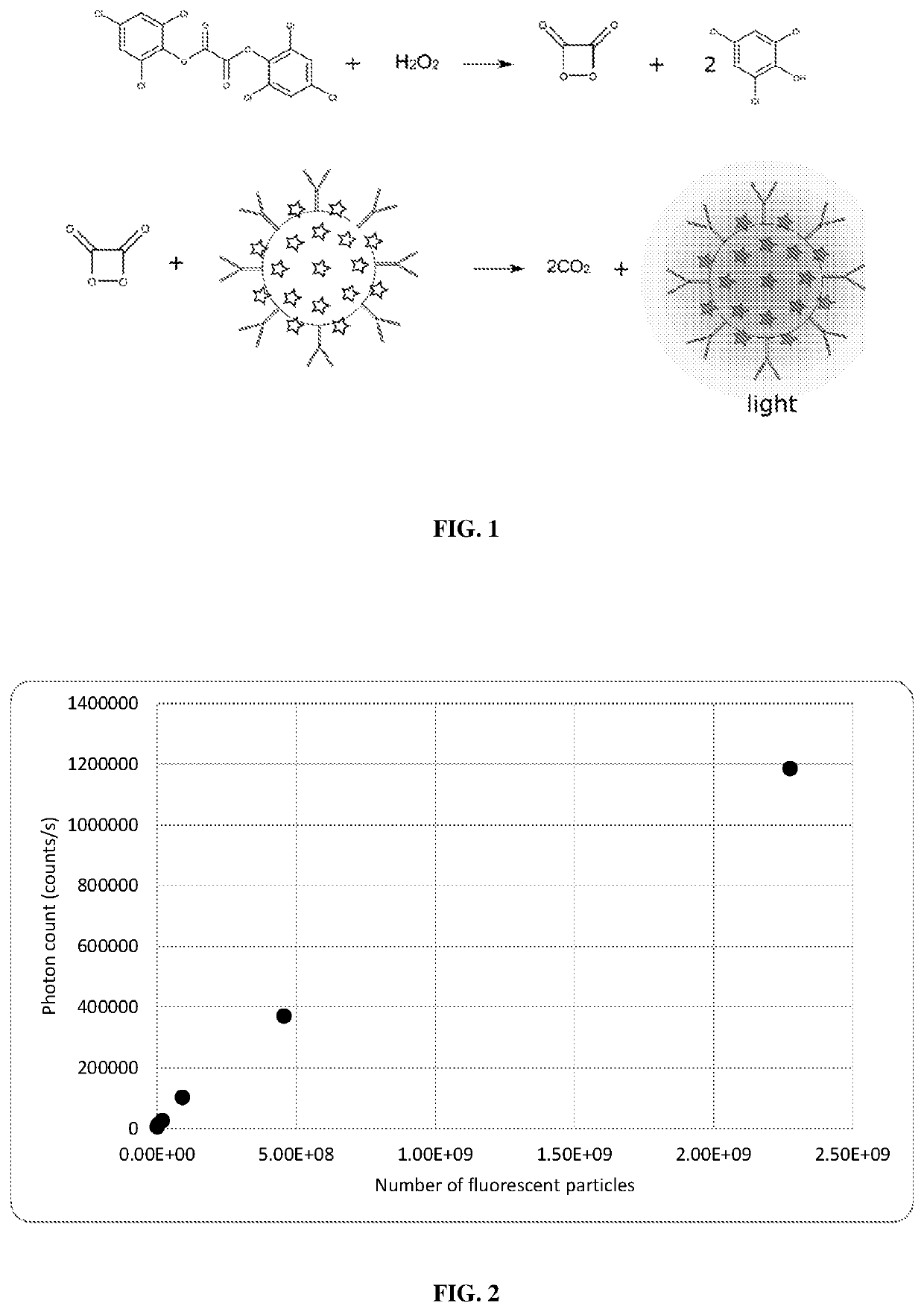Non-enzymatic glow assays
a glow assay and non-enzymatic technology, applied in the field of immunoassays, can solve the problems of limited sensitivity to about five parts per billion, weakness of current test formats, and insufficient quantitativeness, and achieve the effect of short completion tim
- Summary
- Abstract
- Description
- Claims
- Application Information
AI Technical Summary
Benefits of technology
Problems solved by technology
Method used
Image
Examples
example 1
Singlet Oxygen Excitation of LFA Reporter Particles
[0114]In an exemplary embodiment, a line of monoclonal antibody recognizing the NS1 protein of serotype 2 of dengue virus is deposited across a nitrocellulose lateral flow membrane. 50 microliters of human fingerstick blood is applied to the membrane through a Vivid blood filter. This is followed by 100 microliters of buffer containing nanoparticles comprising thioxene and a europium chelate and decorated with a second monoclonal antibody to the dengue NS1 protein, where the first and second antibodies are capable of binding simultaneously to the same NS1 protein molecule. The lateral flow membrane is then washed with an additional 50 microliters of buffer and three drops of a solution containing the singlet oxygen generator protein is applied. The lateral flow membrane is then illuminated for one minute, then imaged for light emission in a closed chamber for 10 seconds, and the presence of a brightly emitting line at the location o...
example 2
Chemiexcitation of LFA Reporter Particles for Sensitive Imaging Detection
[0115]A lateral flow sandwich immunoassay is conducted on a porous membrane such as Fusion 5 strip with a sandwich pair of antibodies recognizing HIV core antigen p24. The reporter particles bearing the detector antibody are fluorescent. A human plasma sample is mixed with a biotinylated antibody recognizing an epitope of HIV p24 and with fluorescent nanoparticles bearing a different antibody recognizing a second epitope of p24. The mixture is flowed along a Fusion 5 LFA membrane with a neutravidin test line and anti-species control line. After the sample has been run, 200 microliters of a solution of oxalate ester and hydrogen peroxide is applied to the strip, which is then imaged with a cell phone camera in a dark box. The chemiexcitation of the fluors on the particle produces a bright emission at the test line, which is numerically integrated and divided by the emission at the control line to estimate the co...
example 3
Chemiluminescence Resonance Energy Transfer (CRET)
[0117]Homogeneous assay by FRET between chemiexcited donor and non-chemiexcitable acceptor 200 nanometer fluorescent particles with a fluorescence emission maximum near 490 nanometers are modified with antibodies to capsular polysaccharide of Burkholderia pseudomallei. Other antibodies recognizing the same target are modified with Alexa Fluor 488 dye. The particles and Alexa Fluor 488 dye-conjugated antibodies are freeze-dried in an optical cuvette. For use, 500 microliters of a human urine sample are added to the cuvette, followed by a diethyl phthalate solution of oxalate ester and 10 microliters of hydrogen peroxide solution. After mixing, light emission near the Alexa Fluor 488 dye emission maximum of 525 nanometers is ascribed to energy transfer between the chemiexcited fluors of the fluorescent particles and Alexa Fluor 488 dye on the detector antibody. Alexa Fluor 488 dye is not chemiexcited under these conditions, so its exci...
PUM
| Property | Measurement | Unit |
|---|---|---|
| diameter | aaaaa | aaaaa |
| diameter | aaaaa | aaaaa |
| completion time | aaaaa | aaaaa |
Abstract
Description
Claims
Application Information
 Login to View More
Login to View More - R&D
- Intellectual Property
- Life Sciences
- Materials
- Tech Scout
- Unparalleled Data Quality
- Higher Quality Content
- 60% Fewer Hallucinations
Browse by: Latest US Patents, China's latest patents, Technical Efficacy Thesaurus, Application Domain, Technology Topic, Popular Technical Reports.
© 2025 PatSnap. All rights reserved.Legal|Privacy policy|Modern Slavery Act Transparency Statement|Sitemap|About US| Contact US: help@patsnap.com


